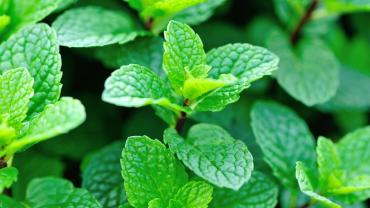
Around this time of year, as festive lights and decorations go up to bring holiday cheer, certain delicious treats also make their way into menus and kitchens worldwide. Peppermint candy canes with their twisted red-and-white stripes, peppermint hot chocolate, peppermint bark, cakes, cookies, and fudge, even peppermint lattes, become ubiquitous and intertwined with the merriment, aroma, and flavor of the season. Peppermint’s cool and crisp flavor symbolically reflects the frosty weather, while also adding a fresh flair in contrast to the richness of most holiday treats.
Why is peppermint one of the most treasured flavors of the holiday season? The answer may be related to the popularity of candy canes during this time of year. Legend has it that sometime around 1670 a choirmaster in Cologne, Germany gave sugar sticks to young singers to keep them quiet during a nativity scene and bent the candies to make them look like a shepherd’s staff. Many years later, in 1847, candy canes are said to have made their holiday debut in the U.S. when a German-Swedish immigrant named August Imgard decorated a small blue spruce tree with them in Wooster, Ohio.
Whether peppermint’s popularity during the holidays is due to candy canes, to its availability in winter, or to its cool crisp flavor reminiscent of the frosty weather may be up for debate. What we do know, however, is that peppermint contains the phytochemical menthol, which is responsible for that icy cool taste. Scientists have discovered a link between the experience of cold and a protein called TRPM8, which is a sensor for cold temperatures in skin neurons and a receptor for menthol. Menthol essentially “tricks” the brain into that cool sensation because it activates the same receptor in nerve fibers that is involved in sensing cold. Menthol’s effect on cold receptors may also satiate thirst, facilitate breathing, and promote alertness.
Peppermint (Mentha x piperita) has several other properties that may also be supportive for maladies that often accompany the holiday season. It has been shown to support the digestive system and healthy inflammatory responses, which may be helpful given the abundance of rich meals and treats during the holidays. Peppermint may also promote normal stress responses if the hustle and bustle of the holidays become a bit too overwhelming, since this botanical has been shown to support cognitive health, mood, and normal neurological responses. Peppermint oil may also support sore muscles and joints, which could result from hours spent browsing through shopping centers and markets, strolling through light shows, or ice skating.
Another aspect of peppermint may be of interest when the time comes for New Year’s resolutions. In vivo studies have shown that certain botanicals and phytochemicals, including peppermint, may play a supportive role in phase I detoxification. Peppermint may support radical scavenging activity and antioxidant status by increasing the activity of superoxide dismutase and glutathione. So when we make our New Year’s resolutions, if creating a detox plan is one of them, we may consider including peppermint.
Learn more about peppermint and detoxification:
Creating a Holistic Detox Plan for Sustainable Weight Management
Supportive Nutrients for Phase I Liver Detoxification
Cruciferous Vegetables to Promote Liver Detox
By Antonia Toupet, PhD